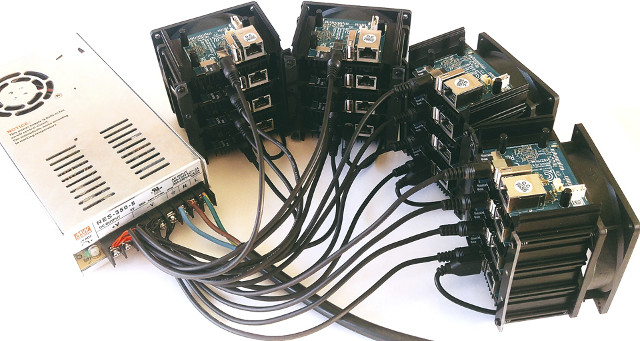Hardkernel teased us with ODROID HC1 Home Cloud server, and ODROID MC1 cluster last August with both solutions based on a cost down version of ODROID-XU4 board powered by Samsung Exynos 5422 octa-core Cortex-A15/A7 processor. ODROID-HC1 Home Cloud server was launched shortly after in September for $49.
It took a little longer than expected for the cluster to launch, but ODROID-MC1 (My Cluster One) is finally here with four ODROID-XU4S boards, and a metal case with a cooling fan. The solution is sold for 264,000 Wons in South Korea, and $220 to the rest of the world.

ODROID-MC1 cluster specifications:
- Four ODROID-XU4S boards with
- SoC – Samsung Exynos 5422 quad core ARM Cortex-A15 @ 2.0GHz quad core ARM Cortex-A7 @ 1.4GHz with Mali-T628 MP6 GPU supporting OpenGL ES 3.0 / 2.0 / 1.1 and OpenCL 1.1 Full profile
- System Memory – 2GB LPDDR3 RAM PoP
- Network Connectivity – 10/100/1000Mbps Ethernet (via Realtek RTL8153 USB 3.0 to Ethernet bridge)
- USB – 1x USB 2.0 port
- Misc – Power LED, OS status LED, Ethernet LEDs, UART for serial console, RTC backup battery connector
- Power Supply – 5V/4A via 5.5/2.1mm DC jack; Samsung S2MPS11 PMIC, Onsemi NCP380 USB load switch and TI TPS25925 over-voltage, over-current protection IC
- Dimensions – ~ 112 x 93 x 72 mm
 ODROID-XU4S is software compatible with ODROID-XU4 board, so you could just use the Ubuntu images (Linux 4.9 or Linux 4.14), and instructions from the XU4 Wiki, but to make things easier, they’ve provided several tutorials specific to the cluster use case:
ODROID-XU4S is software compatible with ODROID-XU4 board, so you could just use the Ubuntu images (Linux 4.9 or Linux 4.14), and instructions from the XU4 Wiki, but to make things easier, they’ve provided several tutorials specific to the cluster use case:
- Docker Swarm Getting Started Guide to automatize installation on all boards part of the cluster.
- Build Farm setup example with distcc to build the Linux kernel
- JAVA Parallel programming – An environment ready for experimenting with MPJ Express, a reference implementation of the mpiJava 1.2 API.
- PXE remote booting setup
Note that the cluster is not sold with accessories by default, so you’ll need to make sure you also get a Gigabit switch with at least 5 ports, five Ethernet cables, four micro SD cards (8GB or greater), and four 5V/4A power supplies (or other 80W+ power supply arrangement as shown below).

Jean-Luc started CNX Software in 2010 as a part-time endeavor, before quitting his job as a software engineering manager, and starting to write daily news, and reviews full time later in 2011.
Support CNX Software! Donate via cryptocurrencies, become a Patron on Patreon, or purchase goods on Amazon or Aliexpress





